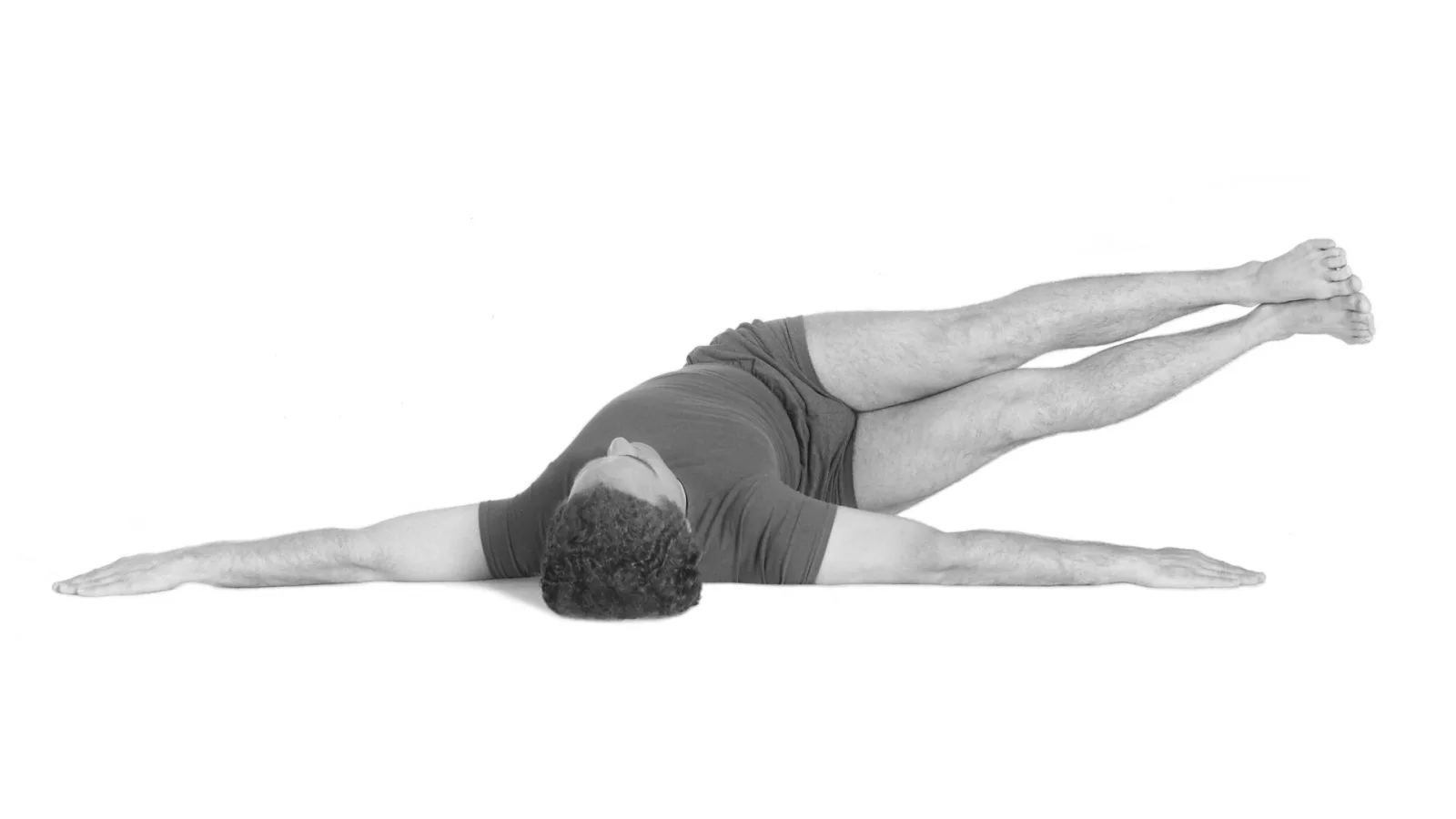
Jathara Parivartanasana—The Abdominal Twist
The many aspects of yoga are ultimately rooted in the Vedas—the ancient scriptures revealed to the rishis, or seers. The Vedas have since given rise to the Upanishads, the Puranas, and thousands of other texts, including those expounding various forms of yoga. According to Vedic cosmology the universe emerges from the fire of consciousness, and fire (agni) plays a central role in all aspects of the universe, from manifest to subtle, and in all levels of our individual being.
The dormant fire of consciousness latent in everyone is known as kundalini, while the active form of fire is prana. In our search for higher consciousness we are seeking to awaken that dormant fire. There are many ways of doing this, ranging from the practices of hatha yoga to cultivating devotion to the Divine—all of which will improve our vitality and increase our store of prana. In particular the practices of hatha yoga are useful for stoking the inner fire, which not only keeps us healthy and vibrant but also transforms our base nature into divine nature.
The dormant fire of consciousness latent in everyone is known as kundalini, while the active form of fire is prana.
Agni exists in numerous forms, or tongues, all of which have different functions; and of the many tongues the one of primary concern to us as yoga students, at least initially, is the digestive fire, or jatharagni. In the human body the home of jatharagni is in the abdomen, where it is responsible for transforming food into nourishment. And it is because of jatharagni that we are able to maintain a physical body. What is more, a balanced digestive fire is the foundation of good health and the beginning of awakening into higher consciousness.
Unfortunately, a combination of bad diet, stress, lack of proper exercise, unhealthy relationships, worry, anger, and low-quality food, air, and water have left many of us depleted. Then, when our vitality declines, the digestive fire becomes too weak to accept the offering we make when we eat, and this results in digestive problems, allergies, sloth, inertia, or fatigue. At the subtle level we are not motivated to do anything for ourselves, and cannot muster the energy it takes to work with our negative mental tendencies. We sink into a morass of ill health, lack of motivation, anger, insecurity, and self-doubt. The question then becomes: How can we break this downward spiral in physical and mental strength?
Fortunately, many of the asanas work directly with the abdomen, the home of digestive fire. They strengthen digestion by improving and balancing the function of the abdominal organs, including the liver, pancreas, and small intestine. Abdominal work also tones the eliminative system (an integral part of the digestive system) and all the other organs of the abdomen, including those of the reproductive system. These asanas also strengthen the supporting muscles and tissues, resulting in more efficient, balanced structural alignment; this is intimately tied to the proper functioning of soft tissues and organs. On a more subtle level the many nerve plexuses in the abdomen and lower spine are stimulated by abdominal work, and this also improves physiological functioning.
Fortunately, many of the asanas work directly with the abdomen, the home of digestive fire.
Beyond mere physical health, when jatharagni is high the skin glows, the eyes are bright, and we are enthusiastic, cheerful, courageous—able to more easily digest the poisons of life, be they dietary indiscretions or difficult life situations. On top of that, because the navel center is the center of power in the body, strong, flexible abdominal muscles facilitate many other asanas.
One of the finest poses for physically strengthening and toning the abdomen is jathara parivartanasana—the turning around of the abdomen. This pose resembles double leg lifts, but here the legs are lowered out to the side instead of straight up and down. A strong lower back is a prerequisite: if you are not regularly doing double leg lifts, start with the bent-knee variation of jathara parivartanasana, and lower the legs only as far as is comfortable.
Jathara Parivartanasana with Bent Knees
Lie on your back with your legs together and extended on the floor. Stretch the arms out to the side at shoulder height. Bend the knees and bring them to the abdomen. To get in touch with abdominal muscles deep in the lower pelvis, contract the pelvic floor between the pubic bone and the tailbone, and draw it up as you press the lower back into the floor. Take a few breaths here, allowing the upper abdomen to be soft and receptive so the breath is free, full, and relaxed. Then relax the pelvic floor for a few more breaths.

To come into the pose, again contract the pelvic floor and press the lower back down so the whole lower abdomen is active. Press the shoulders into the floor and slowly lower both knees toward the right. Lower half way, or less if you feel a pull on the lower back. Then return to center and lower halfway or less to the left. Keep the knees and ankles together, the lower abdomen active, the shoulders pressed into the floor, and the neck, jaw, face, and eyes soft and relaxed. Repeat as a gentle side-to-side roll, breathing easily. This massage gently stretches the lower back and prepares you for a deeper stretch.

To turn the abdomen even further, bring the feet to the floor close to the pelvis. Then shift the pelvis to the left so the right hip is closer to the central axis of the body.

Bend the knees to the abdomen, contract the pelvic floor as before, and lower the knees toward the floor. Keep the left knee in line with the right and keep the ankles together. Press the left shoulder down and allow the whole spine and torso to lengthen. Keep the neck long and the head centered. Shifting the pelvis and keeping the knees one on top of the other helps focus the pose on the abdomen and muscles of the waist and along the spine, and takes the strain off the lower back. Breathe into the upper abdomen and concentrate on turning the deep abdominal muscles.
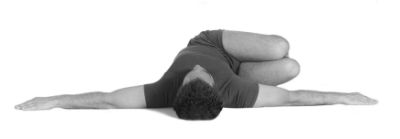
Now lift the legs back to center with an exhalation. Then shift the hips to the right and lower the knees toward the floor to the left. You may also choose to move rhythmically from one side to the other. In that case the knees won’t rest on the floor but will lower and lift smoothly and without pause. The repetitive movement will strengthen the muscles of the abdomen. Be sure to shift the hips to the opposite side before lowering the knees if your lower back feels any strain.
If your knees don’t reach the floor you may want to support them with a cushion thin enough to allow a stretch, but high enough to support the weight of the legs.

Jathara Parivartanasana with Straight Legs
Straight legs are much heavier and more difficult to control than legs with bent knees, so make sure you are quite comfortable with the bent-knee versions before trying this one. If you want to work up to it slowly, an intermediate step between the bent-knee version and the straight-leg version is to fold the knees to the abdomen, shift the hips, rotate the abdomen as you lower the knees to the side, and then straighten the legs. Hold for a breath or two, then again bend the knees and come back to center. This variation will help develop the strength you need to comfortably work with straight legs.
To begin the version with straight legs, keep your attention focused on the lower abdomen, and keep the lower abdominal muscles strongly engaged. The moment you notice the muscles of the lower abdomen losing their grip, or the back arching up off the floor, or the legs falling rather than lowering, bend the knees toward the abdomen and return to the center. If you are working near the edge of your capacity, remember also that what you could do comfortably yesterday is not necessarily what you can do today.
Lying on the floor with your arms stretched out at shoulder height as before, exhale and contract the lower back toward the floor as you smoothly lift the straight legs to a 90 degree angle. (This is a double leg lift.) Keep the sacrum pressed firmly into the floor and the legs actively reaching up.

Now shift the pelvis slightly to the left so the right hip is close to the center line of the body, just as you did with the bent-knee version of the pose.

Squeeze the legs together and contract the pelvic floor, press the left shoulder into the floor, and gently turn the abdomen to the left as you lower the legs to the right. Reach the feet toward the right hand.

Lower the feet as far as you can without straining the back, but without touching the floor. Keep the left shoulder pressed firmly against the floor, and don’t allow the torso to roll toward the legs. Keep the knees and ankles together. Hold and breathe into the upper abdomen for three to five breaths. Then inhale and smoothly lift back to center. Shift the pelvis back to center. Reach up through the legs, press the pelvis down, and take a breath or two before repeating the posture to the left.
The following sequence builds even more strength and fire in the abdomen by combining jathara parivartanasana with double leg lifts. You can apply the same bend-the-knees variation to this sequence also if you need to.
Leg-Lift Sequence
Begin on your back with the arms stretched out to the sides at shoulder height, and the feet together. Inhale and bring your awareness into the lower abdomen. Exhale and draw the pelvic floor in and up as you press the abdomen and sacrum toward the floor and lift the legs to a 90 degree angle.
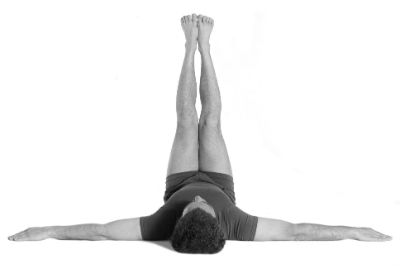
Keep the legs together and reach them up as you press the pelvis down. Inhale and open the legs out to the side, pressing the thighs apart as you press the tailbone down.

Exhale and draw the legs together. Inhale and shift the hips to the left.
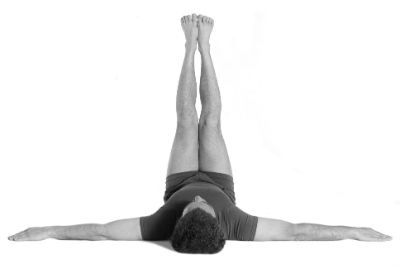
Exhale and lower the straight legs toward the right hand.
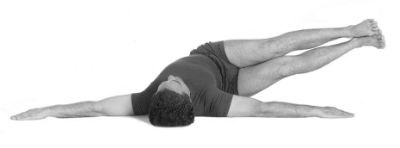
Inhale and lift the legs back to center. Exhale and shift the hips to the center.
Inhale and lower the legs to just off the floor (as in a double leg lift). Exhale and lift back to a 90 degree angle. Inhale and shift the hips to the right. Exhale and lower the legs toward the left hand. Inhale and lift the legs back to center. Exhale and center the hips. Inhale and open the legs out to the side once again. Exhale and bring the legs together. Inhale and reach up through the feet, pressing the pelvis down as you lower the legs to the floor. Repeat the sequence five to ten times, or as your strength allows.
The Virtues of Self-Effort
A regular program of abdominal work will soon put you on the road to greater strength and vitality. It is said that the awakening of higher consciousness is due to divine grace, that the descending forces—the awakened fire—kindles the latent fire within us, and that it is grace that awakens the fire of consciousness. But let us not forget the role of mundane self-effort while we’re waiting for grace. Let us be prepared, let us make every effort to live healthy, happy, and productive lives so that we light our own lamps and, in our own way, help to illuminate the path for others.